THE DOGRUN
a place to share ideas
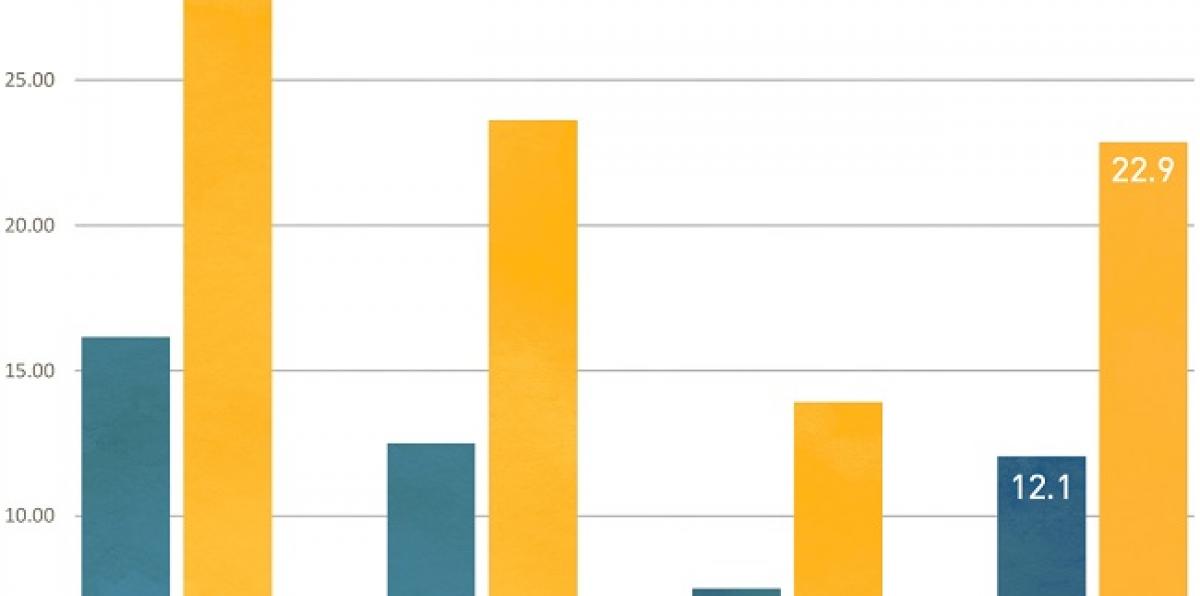

Vertical vs Horizontal
Posted by AHeisserer on 10/22/15 at 2:10 pm
Today we answer the age-old question that has plagued humanity for centuries: Should east and west-facing windows have vertical or horizontal louvers?
We used COMFEN software to test a 20' x 15' room in Austin, Texas with a 10' ceiling. Each room had a floor-to-ceiling west-facing window with a low-E IGU and one of three differently proportioned louvers. Those three louver spacing to louver depth ratios were 1:1, 1:0.67, and 1:0.33.
 Both vertical and horizontal louvers were tested for heat gain, HVAC energy costs, daylighting, and glare.The results: Horizontal louvers out-perform vertical louvers in almost every category!
Unless they are sufficiently deep (or operable), vertical louvers are not as effective at preventing the high-angled summer sun from reaching the window. West-facing horizontal louvers offer similar benefits to south-facing horizontal louvers: They allow relatively low heat gain during warm months, and relatively high heat gain during colder months.
Both vertical and horizontal louvers were tested for heat gain, HVAC energy costs, daylighting, and glare.The results: Horizontal louvers out-perform vertical louvers in almost every category!
Unless they are sufficiently deep (or operable), vertical louvers are not as effective at preventing the high-angled summer sun from reaching the window. West-facing horizontal louvers offer similar benefits to south-facing horizontal louvers: They allow relatively low heat gain during warm months, and relatively high heat gain during colder months.
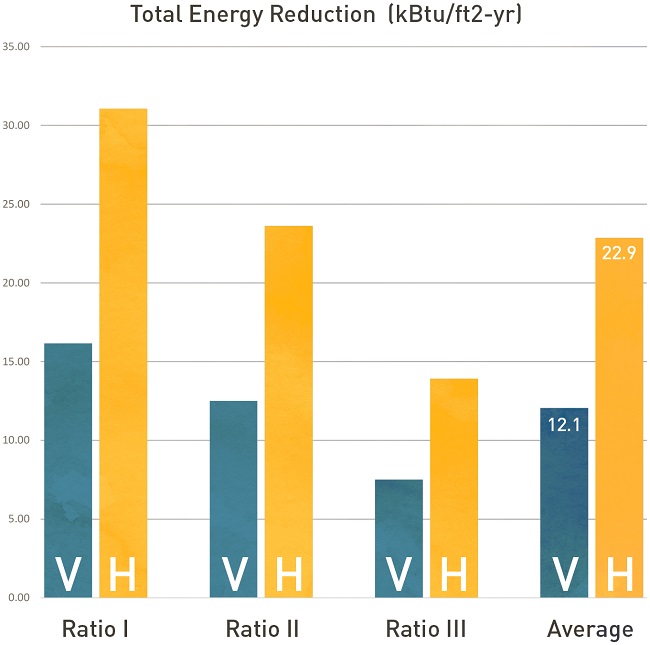 Compared to a controlled scenario with no louvers, the average vertical louver saves about 12 kBtu per square foot each year, and horizontal louvers save almost twice as much energy at 23 kBtu/ft2-yr.
Compared to a controlled scenario with no louvers, the average vertical louver saves about 12 kBtu per square foot each year, and horizontal louvers save almost twice as much energy at 23 kBtu/ft2-yr.
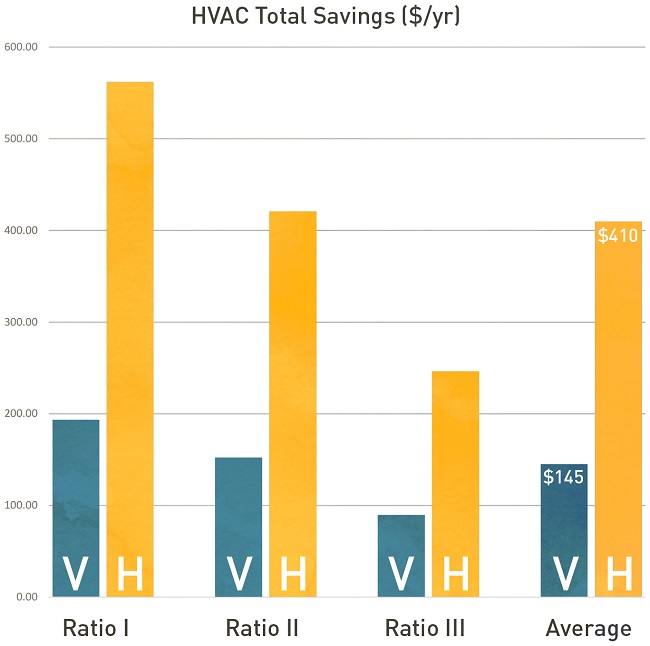 This energy reduction translates to $410 in savings each year in HVAC costs with horizontal louvers, and $145 a year with vertical louvers.
This energy reduction translates to $410 in savings each year in HVAC costs with horizontal louvers, and $145 a year with vertical louvers.
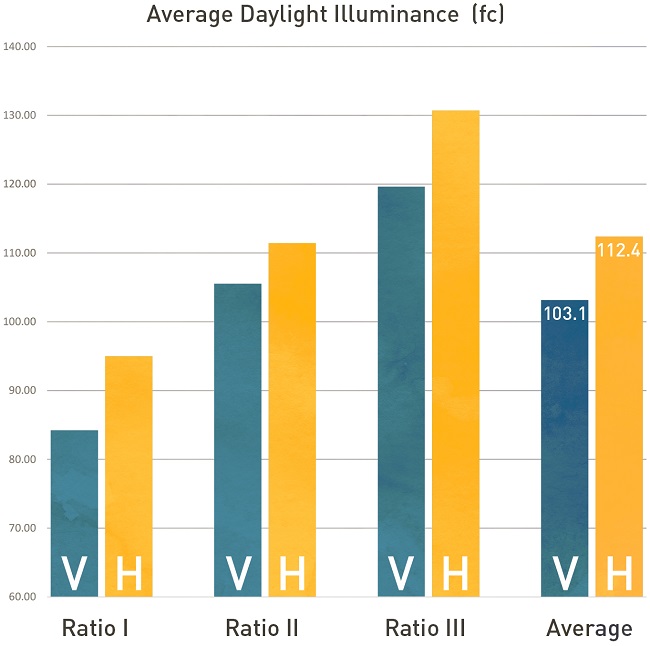 Horizontal louvers slightly out-perform vertical louvers in daylighting, providing an average of 112 footcandles more than the control, compared to 103 footcandles for vertical.
Horizontal louvers slightly out-perform vertical louvers in daylighting, providing an average of 112 footcandles more than the control, compared to 103 footcandles for vertical.
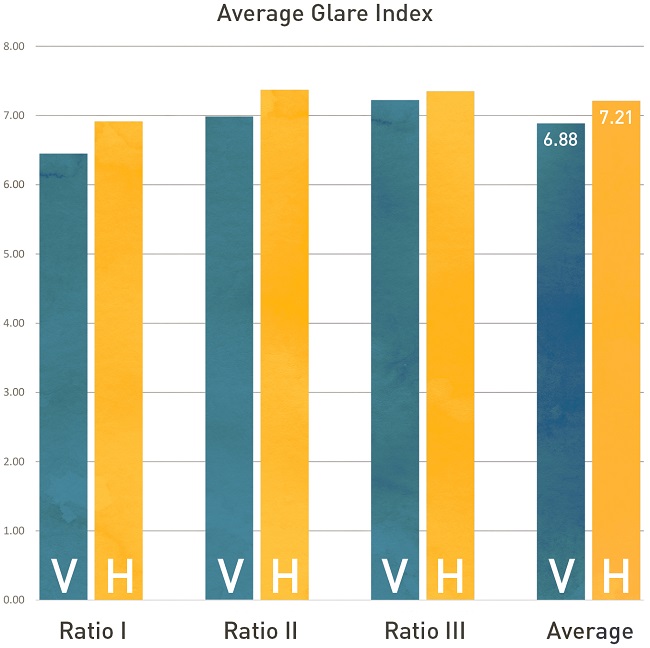 Vertical louvers are a slightly better option for overall glare reduction, though both are much better than having no louvers at all.
Additional tests revealed similar results for east-facing windows and for different locations around the country, proving that over the course of a year, horizontal louvers are typically the best option for east and west-facing windows.
Vertical louvers are a slightly better option for overall glare reduction, though both are much better than having no louvers at all.
Additional tests revealed similar results for east-facing windows and for different locations around the country, proving that over the course of a year, horizontal louvers are typically the best option for east and west-facing windows.
 Both vertical and horizontal louvers were tested for heat gain, HVAC energy costs, daylighting, and glare.The results: Horizontal louvers out-perform vertical louvers in almost every category!
Unless they are sufficiently deep (or operable), vertical louvers are not as effective at preventing the high-angled summer sun from reaching the window. West-facing horizontal louvers offer similar benefits to south-facing horizontal louvers: They allow relatively low heat gain during warm months, and relatively high heat gain during colder months.
Both vertical and horizontal louvers were tested for heat gain, HVAC energy costs, daylighting, and glare.The results: Horizontal louvers out-perform vertical louvers in almost every category!
Unless they are sufficiently deep (or operable), vertical louvers are not as effective at preventing the high-angled summer sun from reaching the window. West-facing horizontal louvers offer similar benefits to south-facing horizontal louvers: They allow relatively low heat gain during warm months, and relatively high heat gain during colder months.
 Compared to a controlled scenario with no louvers, the average vertical louver saves about 12 kBtu per square foot each year, and horizontal louvers save almost twice as much energy at 23 kBtu/ft2-yr.
Compared to a controlled scenario with no louvers, the average vertical louver saves about 12 kBtu per square foot each year, and horizontal louvers save almost twice as much energy at 23 kBtu/ft2-yr.
 This energy reduction translates to $410 in savings each year in HVAC costs with horizontal louvers, and $145 a year with vertical louvers.
This energy reduction translates to $410 in savings each year in HVAC costs with horizontal louvers, and $145 a year with vertical louvers.
 Horizontal louvers slightly out-perform vertical louvers in daylighting, providing an average of 112 footcandles more than the control, compared to 103 footcandles for vertical.
Horizontal louvers slightly out-perform vertical louvers in daylighting, providing an average of 112 footcandles more than the control, compared to 103 footcandles for vertical.
 Vertical louvers are a slightly better option for overall glare reduction, though both are much better than having no louvers at all.
Additional tests revealed similar results for east-facing windows and for different locations around the country, proving that over the course of a year, horizontal louvers are typically the best option for east and west-facing windows.
Vertical louvers are a slightly better option for overall glare reduction, though both are much better than having no louvers at all.
Additional tests revealed similar results for east-facing windows and for different locations around the country, proving that over the course of a year, horizontal louvers are typically the best option for east and west-facing windows.